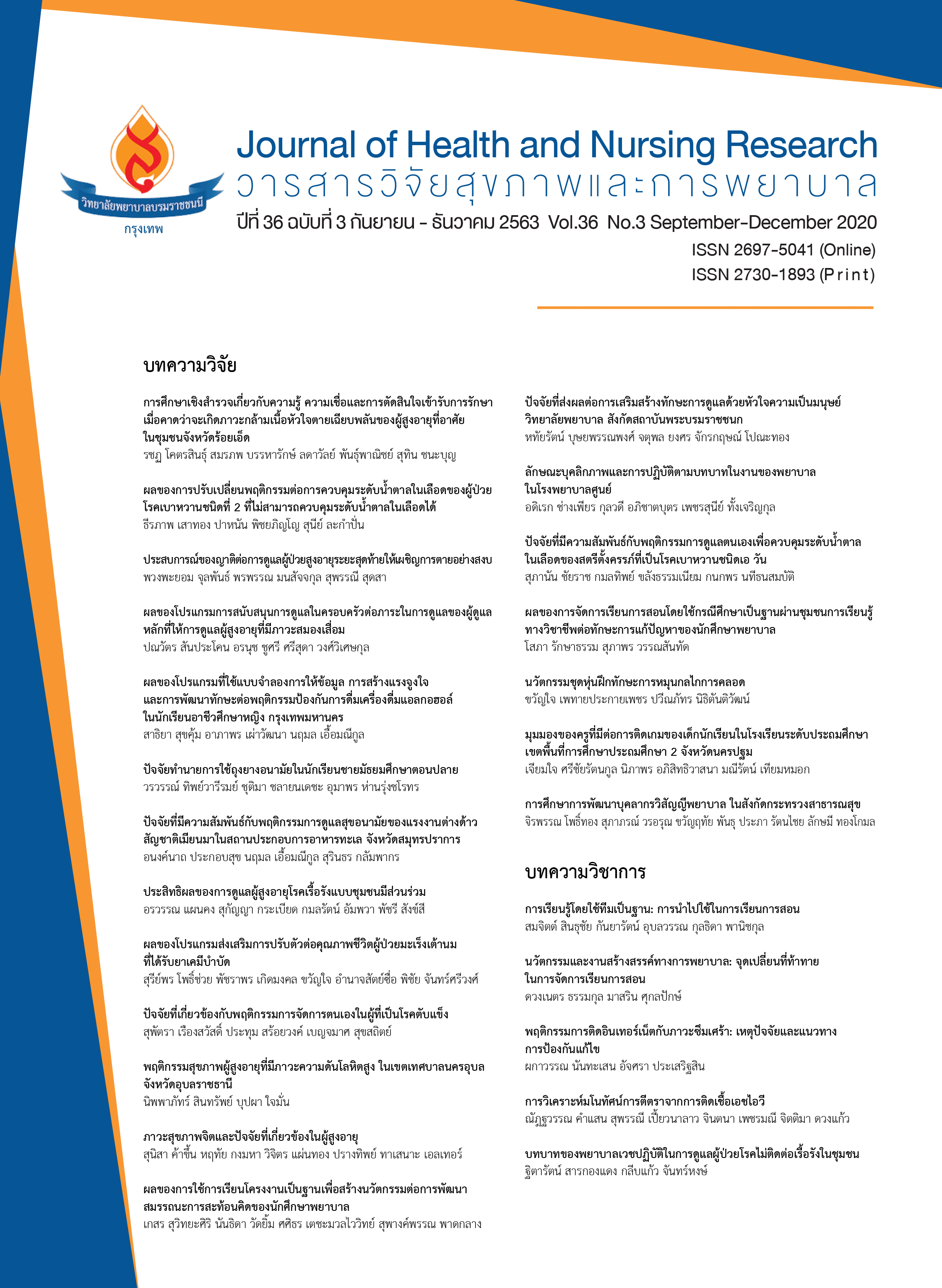ปัจจัยทำนายการใช้ถุงยางอนามัยในนักเรียนชายมัธยมศึกษาตอนปลาย
คำสำคัญ:
การใช้ถุงยางอนามัย, นักเรียน, IMB model, มัธยมศึกษาบทคัดย่อ
แนวโน้มการใช้ถุงยางอนามัยของนักเรียนเพิ่มสูงขึ้นเนื่องจากยุทธศาสตร์ถุงยางอนามัยแห่งชาติของกระทรวงสาธารณสุข แต่อัตราป่วยด้วยโรคติดต่อทางเพศสัมพันธ์ในวัยรุ่นและเยาวชน อายุ 15-24 ปี ก็เพิ่มขึ้นอย่างต่อเนื่องเช่นกัน การวิจัยนี้เป็นการศึกษาภาคตัดขวาง (Cross-sectional study) มีวัตถุประสงค์เพื่อหาปัจจัยทำนายการใช้ถุงยางอนามัยในนักเรียนชายชั้นมัธยมศึกษาตอนปลาย โดยใช้กรอบแนวคิด Information-Motivation-Behavioral skills model กลุ่มตัวอย่าง คือ นักเรียนชายที่ศึกษาในระดับชั้นมัธยมศึกษาตอนปลาย ในเขตอำเภอเมืองพิษณุโลก 10 โรงเรียน จำนวน 448 คน ปีการศึกษา 2561 โดยการสุ่มตัวอย่างแบบแบ่งชั้น เก็บรวบรวมข้อมูลโดยใช้แบบสำรวจการใช้ถุงยางอนามัย ประกอบด้วย ข้อมูลทั่วไป ความรู้เกี่ยวกับโรคติดต่อทางเพศสัมพันธ์ ความรู้เรื่องถุงยางอนามัย ทัศนคติในการใช้ถุงยางอนามัย การพูดคุยสื่อสารเรื่องเพศกับครอบครัวและความสะดวกใจในการพูดคุยเรื่องเพศกับครอบครัว อิทธิพลของเพื่อน และ ความสามารถของตนเองในการใช้ถุงยางอนามัย ซึ่งผ่านการตรวจสอบคุณภาพด้านความตรงเชิงเนื้อหาและความเที่ยงตามเกณฑ์มาตรฐาน วิเคราะห์ข้อมูลโดยใช้สถิติเชิงพรรณนา และการวิเคราะห์การถดถอยโลจิสติกส์
ผลการวิจัยพบว่า นักเรียนชายชั้นมัธยมศึกษาตอนปลายที่มีอายุมาก ผลการเรียนเฉลี่ยน้อย มีการพูดคุยเรื่องเพศกับครอบครัว และความสะดวกใจในการพูดคุยเรื่องเพศมาก ได้รับอิทธิพลของเพื่อนมาก และมีการรับรู้ความสามารถของตนเองในการใช้ถุงยางอนามัยมาก จะมีโอกาสใช้ถุงยางอนามัยเพิ่มขึ้นอย่างนัยสำคัญทางสถิติ (p-value<0.05) เมื่อนำมาวิเคราะห์หาสมการปัจจัยทำนายการใช้ถุงยางอนามัยในนักเรียนชายมัธยมศึกษาตอนปลาย สามารถเขียนสมการถดถอย (y) = -0.497 + 0.118 (อายุ) - 0.240(ผลการเรียนเฉลี่ย) + 0.223(การพูดคุยเรื่องเพศกับครอบครัว)+0.026(ความสะดวกใจในการพูดคุยเรื่องเพศ)+0.073 (อิทธิพลเพื่อน)+0.016(การรับรู้ความสามารถของตนเองในการใช้ถุงยางอนามัย) มีอำนาจการทำนายร่วม ร้อยละ 15.6 (Nagellkerke R2 = 0.156) ผลการศึกษานี้สามารถนำไปพัฒนาโปรแกรมส่งเสริมการใช้ถุงยางอนามัยในนักเรียนชายชั้นมัธยมศึกษาตอนปลายได้
Downloads
เอกสารอ้างอิง
2. Bureau of Epidemiology. Sexually transmitted infections rate among adolescents 15-54 years of age [Internet]. 2018 [cited 2020 February 13]. Available from: http://rh.anamai.moph.go.th/ewt_dl_link.php?nid=86. (in Thai).
3. Thaweesit S, Boonmongkon P, Pushing the boundaries: The challenge of sexuality education in Thailand. In S. Thanenthiran (Ed.), Reclaiming & redefining rights. Thematic studies series 1: Sexuality & Rights Asia (pp. 44-53). Kuala Lumpur, Malaysia: Asian-Pacific Resource & Research Center for Women (ARROW); 2012.
4. Wibulpolprasert S, Sirilak S, Ekachampaka P, Wattanamano N, Taverat R. Thailand Health Profile 1999-2000. Bangkok: Printing Press, Express Transportation Organization; 2001. (in Thai).
5. Boonmongkol P, Promnart P, Samao N, Ojanen T, Guadarmuz T, Burford J, et al. Research report to review sexuality education in Thai educational institutes. Bangkok: Mahidol University; 2016. (in Thai).
6. Bureau of Epidemiology. The surveillance of behaviors related to HIV infection among students in Thailand 2011 [Internet]. 2012 [cited 2020 February 12]. Available from: file:///C:/Users/NR9067/Downloads/report_2012_11_no21.pdf. (in Thai).
7. Tipwareerom W, Weglicki L. Parents’ knowledge, attitude, behaviors, and barriers in promoting condom use among their adolescent sons. Nursing and Health Sciences 2017; 19(2):212-19.
8. Meechamnan C, Fongkaew W, Chotibang, McGrath BB. Do Thai Parents discuss sex and AIDS with young adolescents: A qualitative study. Nursing and Health Science 2014;16:97-102.
9. Sridawruang C, Pfeil M, Crozier K. Why Thai parents do not discuss sex with their children: a qualitative study. Nursing and Health Science 2010;12(4):437-43.
10. Kaewkungwan S. Development psychology life span: Teenager-elderly. 9th ed. Bangkok: Thammasat University Publishing, 2010. (in Thai).
11. Krinara P. Knowledge about sexually transmitted diseases and pregnancy prevention among secondary school students in schools under the Saraburi Municipality. J Prapokklao Hosp Clin Med Educat Center 2013;20:274-86. (in Thai).
12. Tumchueo S. Sexual behaviors and factors correlation with the intention of protection. Nursing Journal of Ministry of Public Health 2015;25(1):97-109. (in Thai).
13. Pinyaphong J. Sexual behaviors and determinant of intension to use condom of young adult male in school, Uttaradit province. Phetchanun Rajabhat Journal 2014; 16(2): 1-11. (in Thai).
14. Tipwareerom W, Powwattana A, Lopvongwatana P. Predictors of risky sexual behaviors among adolescent boys, Phitsanulok Province. Journal of Public Health Nursing 2013; 27(1):31-45. (in Thai).
15. Wongsawat P, Supametaporn P, Hoyrat P. Effectiveness of learning Program for improving sexual communication skills among parents and their adolescent children on premarital sexual and unwanted pregnancy prevention. Journal of Boromarajaonani College of Nursing, Bangkok
2019;35(1):86-98. (in Thai).
16. Powwatana A, Auemaneekul N, Lakampan S. Risk behaviors prevention in adolescence: Concepts and management in multilevel approach. Bangkok: Protexts.com; 2017. (in Thai).
17. Fisher JD, Fisher WA. Changing AIDS risk behavior. Psychological Bulletin 1992;111:455-74.
18. Fisher JD, Fisher WA., Bryan AD, Misovich SJ. Information-Motivation-Behavioral Skills model-Based HIV risky behavior change intervention for inner-city high school youth. Health Psychology 2002;21(2):177-86.
19. Srisatidnarakul B. The methodology in nursing research. 5th ed. Bangkok: You and I inter Media ltd; 2010. (in Thai).
20. Lerand SJ, Ireland M, Boutelle K. Communication with our teens: Associations between confidential service and parent-teen communication. Journal of Pediatric and Gynecology 2007;20:173-78.
21. Thammaraksa P, Powwattana A, Lagampan S, Vatanasomboon P, Stoddard SA. Effects of school-based participation program to prevent multiple risk behaviors in Thai male adolescents. Pacific Rim 2019;23(3):228-42.
22. Cecil H, Pinkerton SD. Reliability and validity of a self-efficacy instrument for protective sexual behaviors. Journal of American College Health 1998;47(3):113-21.
23. Thaiyapirom N. Health promotion in adolescents. In: Klunklin P, editor. Children’s Health promotion. Khonkhan: Klungnana publishing; 2012. (in Thai).
24. Duang-iad K, Suwanmonkha S. Multiple case study research to analyze methods for enhancing mind of high school students. An Online Journal of Education 2014;9(2): 574-81. (in Thai).
25. Suaysaard S. Sex education. Bangkok: V Print Company; 2012. (in Thai).
26. Neinstein LS, Katzman D, Callahan T. Neinstein’s adolescent and young adult health care: a practical guide. 6th ed. Philadelphia: Wolters Kluwer; 2016.
27. Bandura A. Self-efficacy: The exercise of control. New York: Freeman; 1997.
28. Lyles CM, Crepaz N, Herbst JH, Kay LS. Evidence-based HIV behavioral prevention from the perspective of ADA’s HIV/AIDS prevention research synthesis team. AIDS Educ Prev 2006;18(Suppl):21-31.
29. Dilorio C, Dudly WN, Soet J, Watkins J, Maibach E. A social cognitive-based model for condom use among college students. Nursing Research 2000;49:408-14.
30. Visudibhan PJ. Predictors of condom use and intention to use condom among HIV- Infected patients/AIDS with their couples. Rama Nurs J 2015;21(1):69-81. (in Thai).
31. Jeong J, Jo S, Jung M, Lee Y. Factors related to condom use behavior among club-working women in South Korea: Importance of subjective norms and customer-related attitudes. Asia-Pacific Journal of Public Health 2014;26(2):147-59.
ดาวน์โหลด
เผยแพร่แล้ว
รูปแบบการอ้างอิง
ฉบับ
ประเภทบทความ
สัญญาอนุญาต
บทความที่ได้รับการตีพิมพ์ เป็นลิขสิทธิ์ของวารสารวิจัยสุขภาพและการพยาบาล (วิทยาลัยพยาบาลบรมราชชนนี กรุงเทพ) ไม่สามารถนำไปตีพิมพ์ซ้ำในวารสารฉบับอื่น


















